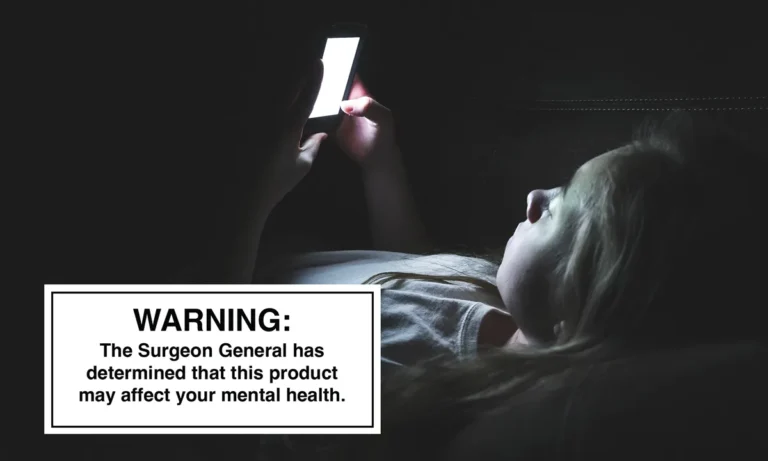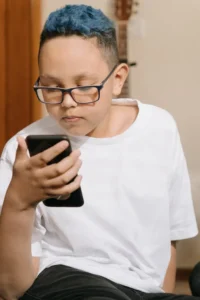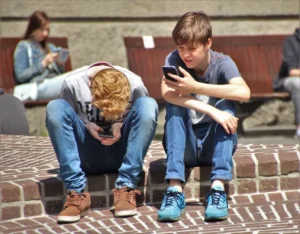The Surgeon General recently dropped a bombshell: social media poses a significant risk to the mental health and well-being of an entire generation.
Let that sink in.
According to the advisory issued by Dr. Vivek Murthy, today’s youth are facing “devastating” impacts from excessive social media use, including depression, bullying, and even suicidal thoughts.
The statistics are downright alarming. Over 95% of adolescents are active on social media, with some spending upwards of 10+ hours per day scrolling, posting, and commenting. This hyper-connectivity is hijacking the brains of our youth during critical windows of development.
And the outcomes? Skyrocketing diagnoses of anxiety, self-harm, and suicidal ideation in teenagers over the last decade, especially among girls who may be especially vulnerable to negative social comparison.
Murthy’s warning is clear: Social media and youth mental health are on a collision course. The virtual world is inflicting real damage on our kids, and as stakeholders in the next generation’s well-being, it’s our responsibility to take action.
Through this blog, we’ll dive into social media’s risks to youth mental health, where we’ve gone wrong, and what needs to change. The futures of our children depend on the actions we take today.
The Surgeon General’s Warning – A Call to Action
It’s likely no surprise that social media’s impact on our lives has been less than stellar. However, the Surgeon General’s advisory presents alarming data on the impacts of social media on youth mental health:
- Up to 95% of teenagers are active on social media platforms
- On average, teens spend over 3.5 hours per day on social media
- Teens spending over 3 hours a day on social media face double the risk of mental health issues like depression and anxiety
- 46% of teens say social media makes them feel worse about their body image
- 64% of teens are often exposed to hate-based content on social media
- 1 in 3 teens use screens and social media until midnight or later on weekdays
- 30-50% of adolescent girls report feeling “addicted” to certain platforms
The stats themselves paint a grim picture of how social media affects our lives, but the Surgeon General’s advisory goes even further; it warns that parents and guardians should be aware of the potentially adverse effects of exposure to social media.
Imagine how different our children’s mental health could be if we took a strong stand to reduce the amount of time they spend on social media. We can take action and ensure that this generation of young people not only survives but thrives!
Revisiting The Risks and Harms of Social Media
The research outlined in the Surgeon General’s advisory clearly links excessive social media usage with a wide range of mental health risks and harms, especially for adolescents.
Think of your own use of social media – do you ever find yourself mindlessly scrolling for hours, hindering your ability to focus on more important tasks? Do you feel a sense of outrage or envy when you compare your own life to the lives of others? Are you ever tempted to post things that might later be embarrassing, hurtful, or even dangerous?
Several studies have shown a dose-response relationship between time spent on social media and mental health issues like depression and anxiety. Teens spending over 3 hours per day on platforms face twice the risk of developing symptoms of anxiety or depression compared to lighter users. The more time teens spend scrolling and posting, the greater their vulnerability.
Beyond mental health, social media exposes teens to an array of potentially harmful influences:
- Exposure to extreme, inappropriate, or dangerous content such as glorifications of self-harm, suicide, disordered eating, or substance abuse. Social media algorithms can create echo chambers around this content.
- Compromised sleep quality and duration due to nighttime social media use. Studies show a correlation between excessive usage and sleep disorders, which potentially amplify mental health issues.
- Reduced investment in in-person relationships and activities outside the virtual world. Teens absorbed in social media tend to spend less time interacting with family, friends, and hobbies.
- Cyberbullying and online harassment in the form of hurtful comments, gossip, abusive messages, or privacy violations. The effects of cyberbullying compound other social media harms.
While the impacts are wide-ranging, there are also specific populations that face amplified risks from social media’s influences:
- Adolescent girls are particularly susceptible to lowered self-esteem, body dissatisfaction, disordered eating, and even self-harm due to thin-ideal imagery and social comparison pressures on platforms.
- Marginalized teens who lack strong support systems may turn to social media for affirmation or community, exposing them to further harms.
- The mental health of kids who already struggle with self-esteem, depression, or anxiety is especially vulnerable to the negative influences of social media.
The Dual Nature of Social Media – Can It Be Beneficial?
While the mental health risks of excessive social media usage are increasingly evident, it’s important to acknowledge these platforms also provide certain benefits for youth. After all, the rise of social media isn’t just an indication of how we communicate but also a reflection of our need for connection!
For some marginalized teens, social media offers a rare space for connection, community, and identity expression. LGBTQ+ youth, teens with disabilities, and members of minority groups often find acceptance and affirmation through online networks when such support is lacking offline.
- Fostering feelings of peer acceptance and social inclusion for teens who may be isolated or bullied in school. Social media provides a platform to showcase their talents, interests, and individuality.
- Teens can connect with peers sharing niche interests, hobbies, or fandoms they cannot easily engage with in person. The online world gives them a space to explore and celebrate their passions.
- Providing access to social support networks, mental health resources, and crisis intervention services that youth struggling with issues like depression or self-harm can access discreetly.
- Helping teens build self-esteem and confidence through creative expression, activism, and showcasing their skills or achievements on their profiles.
However, many of these potential benefits turn to harm at excessive levels of use. Marginalized teens seeking community may encounter hate groups or bullies online. Those reliant on social media for self-esteem can spiral into social comparison and body image issues.
Roles and Responsibilities of Stakeholders
So, how can we begin to take the Surgeon General’s call to action seriously? The responsibility falls on different stakeholders, including educators, parents, health care providers, and politicians.
Policymakers Must Strengthen Protections and Guardrails
Implement Stringent Privacy Protections
Policymakers should pass legislation strictly limiting how social media companies can collect, utilize, and share personal data from youth users. Children’s privacy must be prioritized over profits.
Policies like the Children’s Online Privacy Protection Act (COPPA) should be updated to address modern data collection practices by social media companies – ensuring that children’s data is secure and protected from potential exploitation or misuse.
Limit Excessive Usage
Laws should be enacted to place guardrails on certain design features that drive compulsive usage among youth, such as infinite scrolling, auto-play, notifications, and algorithmic recommendations.
Usage caps, mandatory breaks, or friction designs could be required to allow more conscious social media use. Fines for non-compliance could help spur change, helping to create a healthier and more secure online environment for children.
Expand Digital Literacy
School-based digital literacy programs focused on social media should be expanded nationwide to educate youth on risks such as privacy concerns, misinformation, and predatory behaviors.
This instruction can empower teens to use social media more responsibly and minimize exposure to harms such as cyberbullying and online harassment.
Fund Independent Research
Policymakers must direct more funding to independent research on the mental health impacts of social media on youth. Too much research relies on limited data provided by tech companies themselves. Government funding of longitudinal studies on social media harms could address this gap.
Technology Companies Must Prioritize User Safety Over Profits
Improve Transparency
Tech companies must be more transparent and grant qualified researchers access to internal data to better understand mental health and safety impacts. Continued resistance to transparency reinforces suspicions that profits are being prioritized over user wellbeing – ultimately undermining public trust.
Prioritize Safety in Design
System design choices like autoplay, infinite scroll, and algorithmic recommendations that drive engagement at the expense of user wellbeing should be reconsidered. Elements such as “dark patterns” that encourage and reward user behavior that is harmful or addictive should be identified and eliminated.
Strengthen Age Safeguards
Parental controls, age verification mechanisms, and default privacy settings should be strengthened to better protect underage users. Loopholes that allow kids to bypass controls must be eliminated. But when thinking about how to protect young users, it’s important to remember that age is not an absolute indicator of maturity.
Remove Harmful Content
Tech companies must be more proactive in identifying and removing content that promotes self-harm, disordered eating, substance abuse, or suicide among youth. Reliance on user reporting is insufficient – AI and human moderation must be employed to help protect young users from harmful content.
Schools and Healthcare Providers Play Critical Support Roles
Integrate Social Media Wellness
Schools and healthcare providers must be engaged in conversations about social media wellness, providing guidance and resources to help young people make informed decisions when interacting on social media. This could include teaching youth digital literacy skills, such as effectively reporting concerning content.
Train Staff on Warning Signs
Teachers, counselors, and other staff require training to recognize signs of social media addiction, isolation, or declining mental health in students. Protocols should guide staff on when and how to approach students exhibiting risky online behaviors.
This can include providing support and resources to students who may be experiencing cyberbullying, online harassment, or even dangerous behaviors such as taking part in cyber extremism.
Offer Youth Support Resources
School-based counseling and peer support groups focused on social media-exacerbated issues like body image, low self-esteem, and social isolation can provide vital lifelines for struggling youth. Referral systems to clinical providers are also critical.
Parents and Caregivers – The Frontline of Defense
Set Healthy Limits on Usage
One of the best ways to help teens manage their mental health is to set healthy, age-appropriate limits on their internet usage.
A good goal would be to prohibit using any electronic device after a certain hour every night and monitor screen time overall. Anything done late at night, like answering emails or engaging in social media, can affect mood and mental functioning.
Discuss Online Safety
Open communication about social media risks and responsible use should begin by mid-to-late elementary school years. As a parent or caregiver, it’s important to let your teen know that they can come to you if something happens online. Let them know that you are a safe place to turn if they encounter any feelings of anxiety or depression.
Model Responsible Habits
Set a positive example by limiting your own social media use around youth and modeling self-control. Avoid shaming kids over normal exploration online, as our digital world is becoming increasingly important for communication, connection, and entertainment.
Watch for Warning Signs
Be alert for possible signs of declining mental health, like social withdrawal, mood changes, sleep issues, or talk of self-harm. Stay attuned to possible indicators of bullying, body image issues, or secret relationships. Don’t hesitate to seek professional support if you feel it is warranted.
Make Time For Unplugged Fun
Encourage children to develop offline hobbies such as painting, playing music, or gardening. Helping young people find activities that are engaging and bring a sense of fulfillment will foster healthy coping skills and reduce isolation.
The Way Forward: Balancing Social Media’s Role in Today’s Culture
While risks exist, social media is part of youth culture now and likely for the foreseeable future. A balanced approach can help maximize benefits and minimize harms – and while there is no single formula, knowing the risks is the first step toward creating a safer, healthier environment for young people.
At AlignUs, we are committed to creating an open, caring space for those looking to take back their mental health from the dangers of social media. Our growing community of individuals and families is striving to create a supportive, inspiring environment that encourages positive expression and growth.
We want to make sure that social media positively contributes to our lives – as an exciting form of communication, entertainment, or an opportunity for self-expression – rather than becoming an obstacle to our mental health.
Together, we can use the power of social media in a healthier way that respects our safety and well-being. With the right tools, understanding, and guidance, we can create an engaging environment that helps us achieve better mental health. Join our community today!




